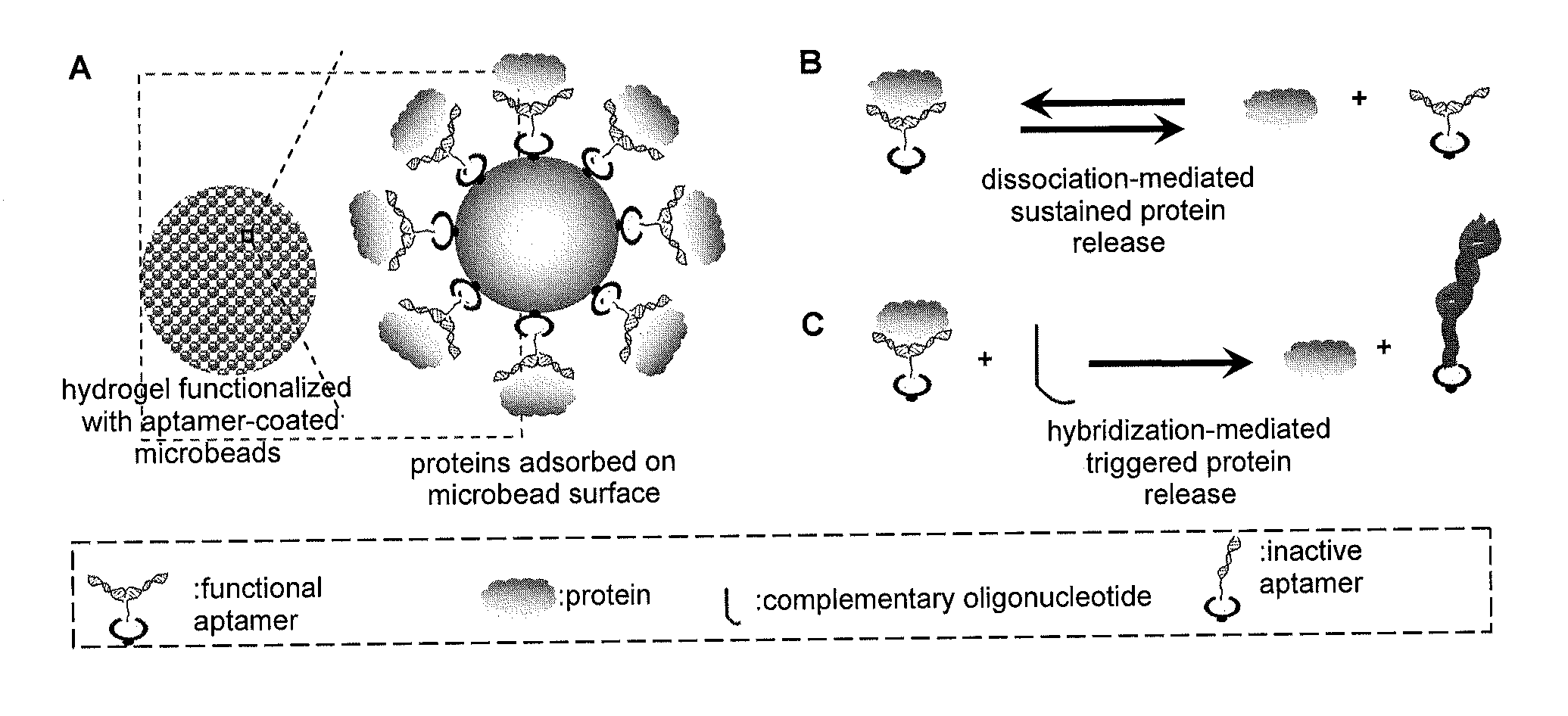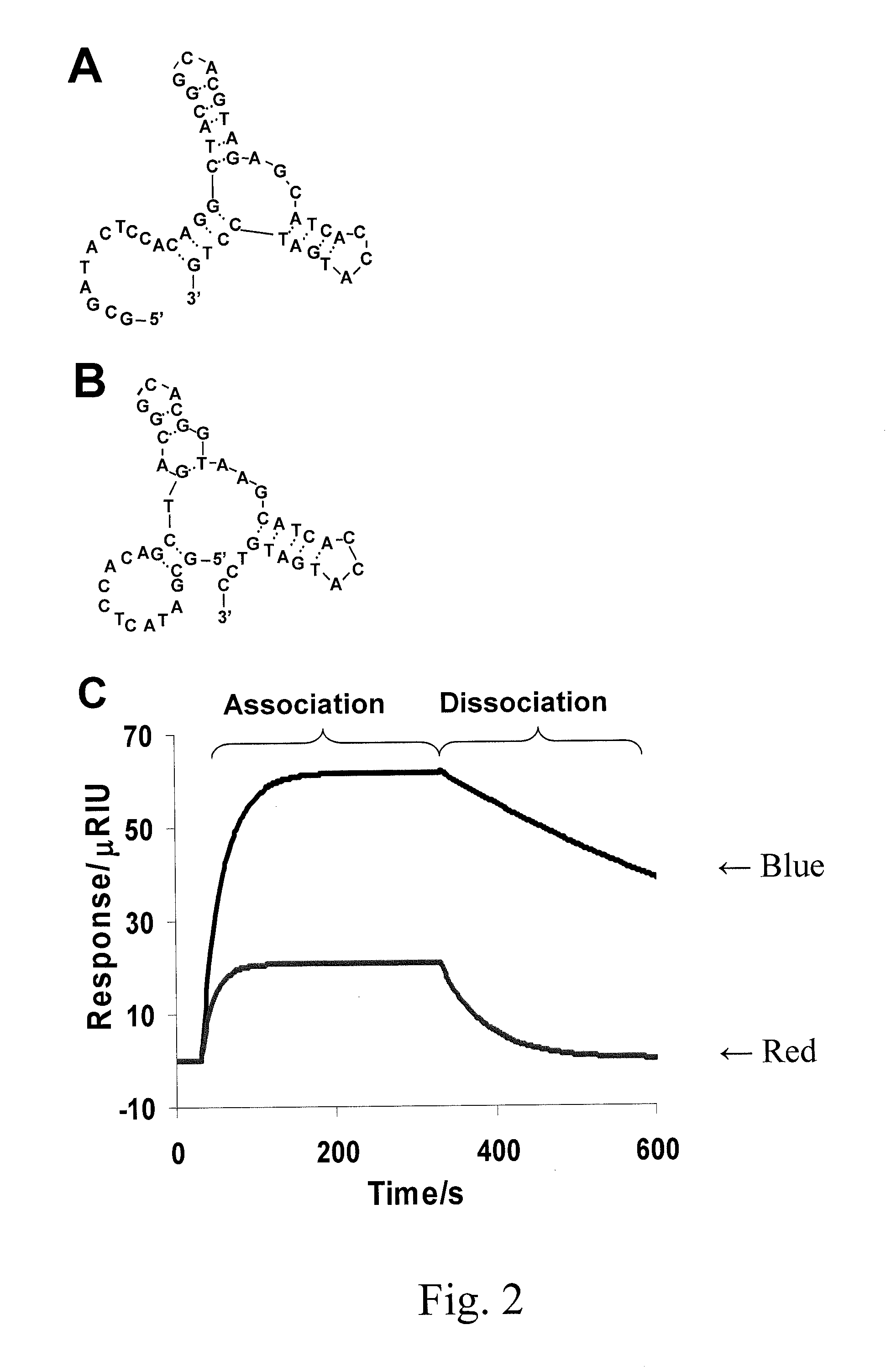Affinity hydrogels for controlled protein release
a technology of hydrogels and controlled protein, which is applied in the direction of peptide/protein ingredients, drug compositions, saccharide peptide ingredients, etc., can solve the problems of unsuitable protein delivery and release methods that rely on liquid formulations that are not suitable for protein delivery and release, increase treatment costs, and wide distribution of protein drugs in non-target tissues, so as to achieve easy control of the release kinetics of different peptides or protein drugs, high binding affinity and specifi
- Summary
- Abstract
- Description
- Claims
- Application Information
AI Technical Summary
Benefits of technology
Problems solved by technology
Method used
Image
Examples
example 1
Hydrogel Functionalization with DNA Aptamers for Sustained PDGF-BB Release
Materials and Methods
Reagents.
[0080]N-ethyl-N-(3-diethylaminopropyl)carbodiimide (EDC), N-hydroxysuccinimide (NHS), Tween 20, ammonium persulfate (APS), N,N,N′,N′-tetramethylenediamine (TEMED), and a premixed solution of acrylamide and bis-acrylamide (40%; 29:1) were purchased from Fisher Scientific (Suwanee, Ga.). The anti-PDGF-BB aptamer (5′- / Acrydite / GC GAT ACT CCA CAG GCT ACG GCA CGT AGA GCA TCA CCA TGA TCC TG-3′; SEQ ID NO:1) and its control aptamer (5′- / Acrydite / GC GAT ACT CCA CAG CTG ACG GCA CGG TAA GCA TCA CCA TGA TGT CC-3′; SEQ ID NO:2) were purchased from Integrated DNA Technologies (Coralville, Iowa). The 10-nt tail sequence is marked in blue. Recombinant Human PDGF-BB was purchased from R&D Systems (Minneapolis, Minn.). Bovine serum albumin (BSA) was purchased from Invitrogen (Carlsbad, Calif.). Human PDGF-BB ELISA development kit was purchased form PeproTech (Rocky Hill, N.J.). Diammonium 2,2′-azi...
example 3
Modulating Aptamer-Protein Interactions with Complementary Oligonucleotides
[0094]One important advantage of the present invention is achieved with the application of complementary oligonucleotides as a molecular trigger to control aptamer-protein interactions and, therefore, release kinetics.
[0095]To demonstrate whether complementary oligonucleotides can efficiently compete with proteins to bind aptamers, PDGF-BB and its different aptamer formats were used as a model system.
[0096]In this example, both aptamers and complementary oligonucleotides are single-stranded nucleic acids. Their nucleotides can form self-assembled base pairs via intramolecular hybridization. When these two molecules are mixed together, intermolecular hybridization competes with intramolecular hybridization to generate double-stranded structures. Moreover, in the presence of proteins, complementary oligonucleotides compete with the binding domains of target proteins. These two competition reactions determine wh...
example 4
Aptamer-Coated Microbeads for Protein Adsorption
[0100]One aspect of the present invention is the entrapment and release of protein drugs in the hydrogels. The feasibility of the use of aptamer-coated microbeads to adsorb, immobilize and release proteins was assessed. When the microbeads are physically mixed with polymer solution to form hydrogels, the proteins are entrapped and incorporated into the hydrogel networks. Because the overall procedure only involves physical mixing, the method could potentially be applied to any type of hydrogel including those hydrogels that cannot be easily functionalized with chemical modification.
[0101]An experiment to test protein adsorption and dissociation on microbead surface was carried out. The model microbeads are streptavidin-functionalized polystyrene microbeads purchased from Spherotech (Lake Forest, Ill.). The anti-PDGF-BB aptamer was chemically modified with biotin. The biotinylated aptamers was mixed with microbeads to coat the aptamers ...
PUM
| Property | Measurement | Unit |
|---|---|---|
| Time | aaaaa | aaaaa |
| Therapeutic | aaaaa | aaaaa |
| Biocompatibility | aaaaa | aaaaa |
Abstract
Description
Claims
Application Information
 Login to View More
Login to View More - R&D
- Intellectual Property
- Life Sciences
- Materials
- Tech Scout
- Unparalleled Data Quality
- Higher Quality Content
- 60% Fewer Hallucinations
Browse by: Latest US Patents, China's latest patents, Technical Efficacy Thesaurus, Application Domain, Technology Topic, Popular Technical Reports.
© 2025 PatSnap. All rights reserved.Legal|Privacy policy|Modern Slavery Act Transparency Statement|Sitemap|About US| Contact US: help@patsnap.com



